Testing Tucsen Discovery M15 sCMOS camera
Tucsen, a laboratory camera maker, introduced new camera - Discovery M15. Recently this camera (in different housing) showed up also at Opticstar. By the description Discovery is a sCMOS, Scientific CMOS camera. The camera costs bit more than $400 (plus shipping and taxes), while typical sCMOS based cameras cost vastly more. So where is the catch? I've decided to test and check this camera.
The camera is using actually a Sony Exmor CMOS sensor - IMX035. The Exmor technology uses per-column A/D converters to reduce read noise, while real sCMOS sensors use much more advanced and doubled A/D conversion system to get even lower noise and high dynamic range (which isn't available for IMX sensor). So Discovery M15 is not a real sCMOS camera. It's close, as it has quite low (3e) read noise and for some reason Tucsen or QImaging (Rolera Bolt) pushed cheap cameras with this sensor tagged as scientific CMOS. The IMX035 sensor can usually be found in relatively cheap machine vision camera (USB3 and USB2 Point Grey cameras for example). Discovery uses slower read mode - quite like to get that low read noise.
In this article I'll review and test a mono Discovery M15 camera at Solar System astrophotography.
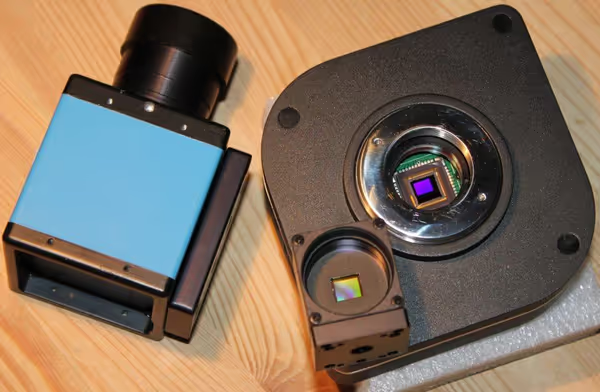
Camera specification
- Sensor: Sony Exmor IMX035 CMOS
- Frame size: 1270 x 1030
- Pixel size: 3.63μm
- Diagonal: 1/3"
- Recording speed: around 20 FPS at full frame, 50-60 FPS at bin2
- Shutter: rolling shutter
- Read noise: 3e
- Interface: USB2
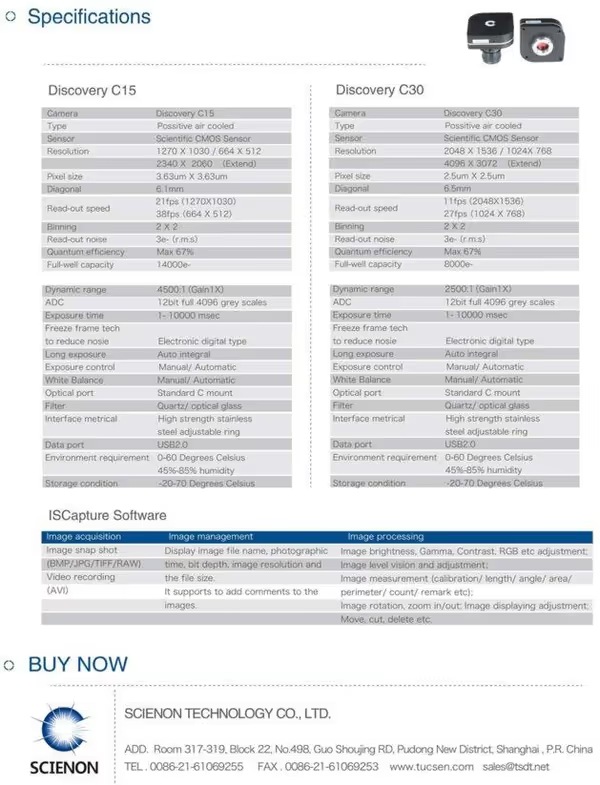
The sensor has quite nice amount of pixels (similar to ICX445 in Chameleon) so it should be good for lunar and solar imaging. Higher framerates available at bin2 allow it to do planetary imaging. Just note that at bin2 you have 7,26 pixel and optimal-maximal focal length for it would be around f/25-30. At bin1 it's half of that value.
As most CMOS sensors this one also has a rolling shutter - the sensors reads row after row. This type of shutter can give artifacts if the image isn't stable enough. For Solar System imaging it can decrease the image quality if the seeing isn't good and thats one of reasons why rolling shuttered sensors are rarely used for astrophotography.
Camera has very low read noise. Typical Micron CMOS (found in QHY5* cameras) has around 20e read noise. Typical Sony CCD in a machine vision camera 6-8e (DMK, Chameleon). This noise is the main noise source in Solar System imaging - and the bigger it is the harder it is to get a clean, noise free image. Discovery gave much better images in white light solar imaging in UV than Ximea xiQ (global shuttered e2v CMOS giving 15-20e read noise). I wasn't able to test it on Jupiter methane band imaging as at bin2 the software didn't allowed longer exposures.
Compared to real sCMOS cameras this camera is quite slow, and it only offers rolling shutter (no global shutter). 3e of read noise is low but sCMOS tend to provide less than 2e. True sCMOS cameras aren't needed for Solar System imaging (but would be very nice). The Discovery camera has good specification aside of few drawbacks (shutter mainly).
Hardware
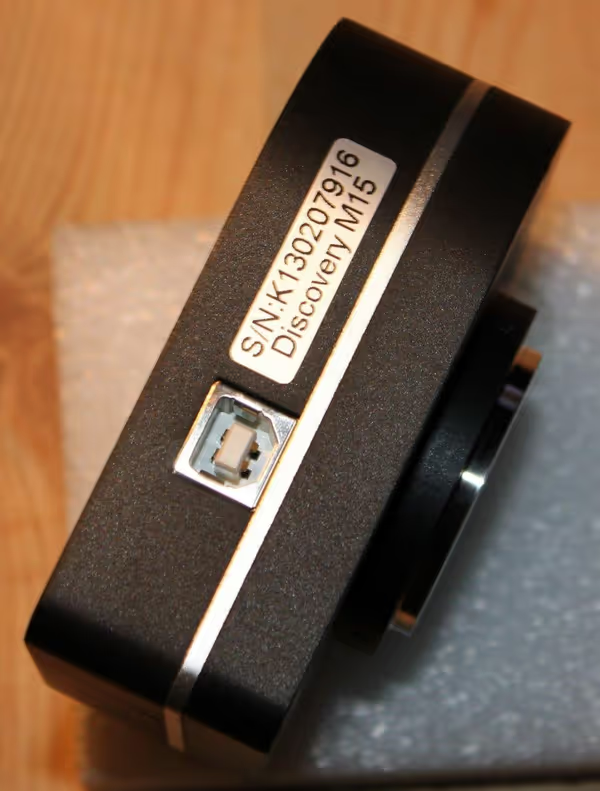
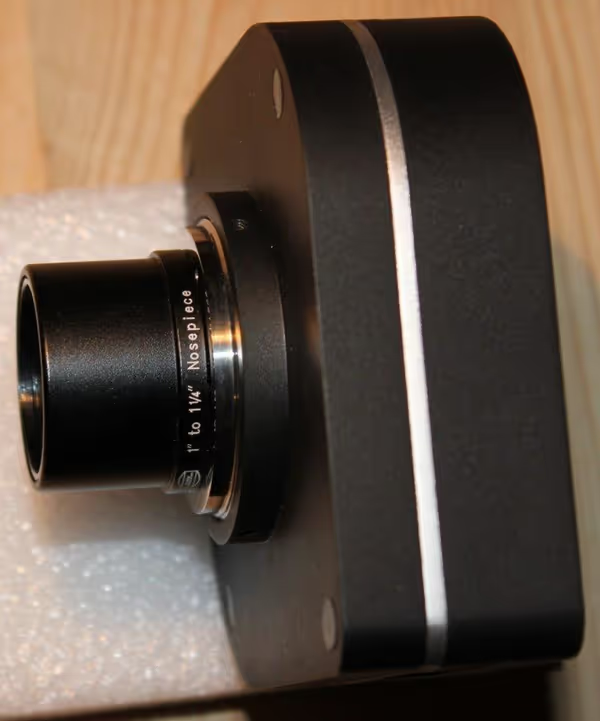
The camera is bigger than DMK21 but not as thick. The housing is solid metal. The sensor is in a sealed chamber with a cover glass at the front. There is no active cooling system.
It's a USB2 camera so it's easy to connect to a computer. It seems to be sensitive to the USB host transfer limitations (like caused by other connected devices) - the recorded framerate falls down.
To connect the camera to a telescope you will need a standard C/CS to 1,25" nosepiece or C/CS to T2 adapter (depending on your needs).
Software - ISCapture
The camera is provided with ISCapture software (not IC Capture for TIS cameras). Like the camera this application is designed for laboratory imaging than recording multiple long AVIs, but it's doable to do some astrophotography with it.
The key is to switch between two tabs - one for exposure/gain settings, and second for recording. In my case the application was stable, but the camera was not. Some times the recording framerate was very low making the camera unusable for recording. Second problem was with AVI length. At up to 500 frames the AVI was saved correctly. More (600 or more) and the AVI gets saved incorrectly making it useless. This happens for bin1 recordings. The bin2 are safe at least up to 2000 frames. The application can also record to BMP/TIFF files.
There is no ROI mode (subframe), only bin2 for smaller frame and faster framerate. The live view may be fitted to window which makes framing easily when the camera frame is bigger than the screen/preview window.
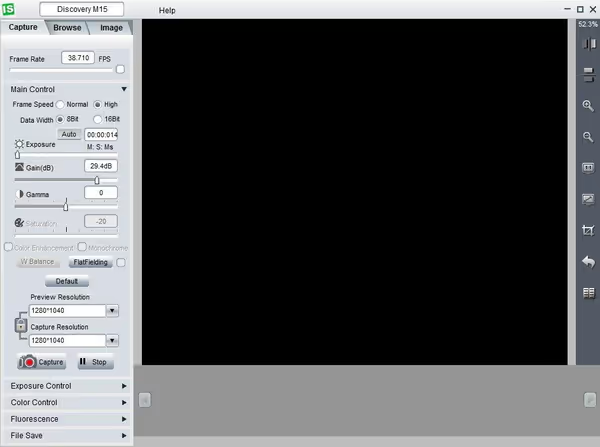
In "Main Control" tab we can set Frame Speed - the normal give lower framerates. Exposure and gain settings are also available here. We can also change from bin1 to bin2.
On the right side we have the live preview menu. We can set the original size (1:1) or fit it to the window for framing.
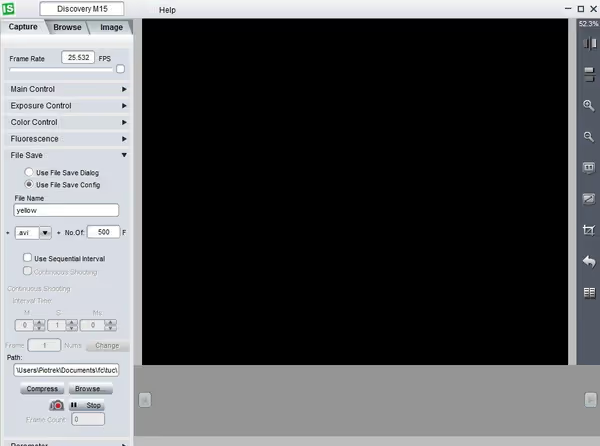
In Files Save tab we can set the format and record data. Camera icon starts the recording.
Test images
Yellow 590 nm bandpass filter and Astrodon UVenus + Baader AstroSolar, TSAPO65Q















Summary
Advantages:- Low read noise
- High framerate at bin2 for planetary imaging
- Solid hardware
- Good image quality
- Problems with recording speed and AVI frame amount
- Lack of very short and longer exposure times
The camera isn't bad, it works, you can do Solar System astrophotography with it, but it's limited, mainly with software (bugs, limited exposure and gain, especially at bin2). Low read noise is handy, like for dimmer Sun UV imaging. For planetary imaging it won't beat ICX618 cameras.
If ISCapture slows down then the camera is useless (clean USB host needed). Limitations on gain and exposure time on bin2 prevent for example methane band imaging (which is annoying as low read noise is handy for such imaging).
If the price is good, and you need such low noise solar/lunar camera (with rolling shutter limitations) then you can think about getting such camera. On the other hand total price of it isn't very "hot" when you compare it to prices of already proven cameras or those announced by proven machine vision camera manufacturers.
Comment article